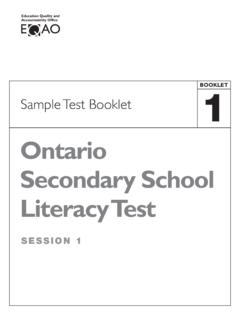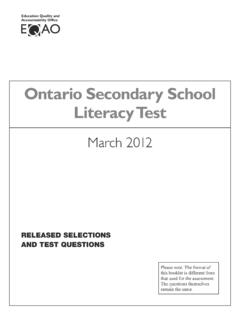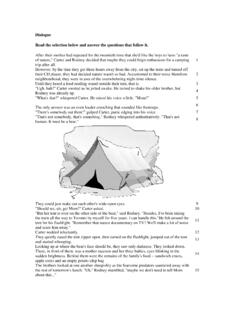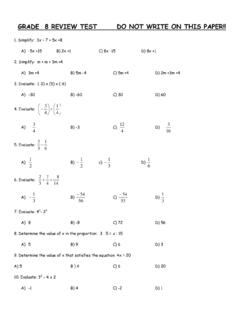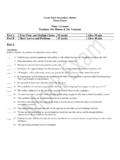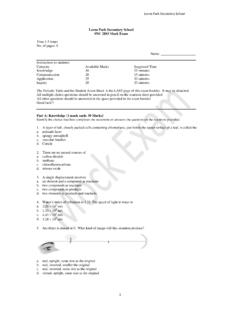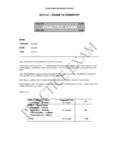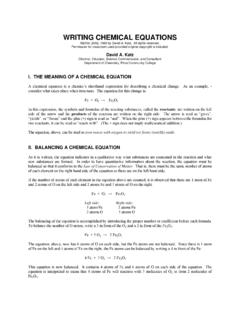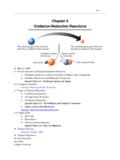Transcription of LORNE PARK SECONDARY SCHOOL SCH 3U PRACTICE …
1 LORNE park SECONDARY SCHOOL SCH 3U PRACTICE FINAL EXAM 1 Course: SCH 3U Student Name: _____ Teacher: Frink Jr. Number of pages: 8 (plus data tables) Length of Exam: h Total marks: 74 marks General Instructions: read instructions carefully look at the marks assigned to help budget time for each question answer all multiple choice questions on the scantron card provided answer all other questions in the spaces provided on this package don t bang your head on the table the data tables attached at the back of the exam may be removed for ease of use nonprogrammable calculators only may be used Multiple Choice Identify the choice that best completes the statement or answers the question. 1 mark each ____ 1.
2 Which of the following matches of group number and common name is incorrect? a. Group 2 - alkaline earth metals d. Group 17 - halogens b. Group 6 - lanthanides e. Group 18 - noble gases c. Group 1 - alkali metals ____ 2. When elements are arranged in order of increasing atomic mass, their chemical properties repeat at regular intervals. This statement is the definition of a. atomic mass d. law of constant composition b. periodic law e. law of conservation of mass c. limitations of the periodic table ____ 3. An electron dot diagram for a nitrogen atom should show a. 1 lone pair and 3 bonding electrons d. 3 lone pairs and 1 bonding electrons b. 2 lone pairs and 2 bonding electrons e. 3 bonding electrons c. 2 lone pairs and 3 bonding electrons ____ 4.
3 The formula for carbon tetrachloride is a. C1Cl4(l) d. CCl4(l) b. C4Cl4(l) e. C4Cl1(l) c. C1Cl(l) ____ 5. An example of a physical change process in a chemical industry is a. deposit of gold on a metal through electrolysis b. decomposition of limestone in the Solvay process c. combustion of sulfur in the contact process for sulfuric acid d. recovery of salt by evaporation of water from a salt lake e. production of ammonia from nitrogen and hydrogen in the Haber process ____ 6. The reaction of silver nitrate with zinc would be classified as a a. combustion reaction d. decomposition reaction b. synthesis reaction e. single displacement reaction c. double displacement reaction LORNE park SECONDARY SCHOOL SCH 3U PRACTICE FINAL EXAM 2 ____ 7.
4 When baking soda is heated, sodium carbonate, water, and carbon dioxide gas are formed. This reaction can be classified as a. synthesis d. single displacement b. combustion e. double displacement c. decomposition ____ 8. Classify the following reaction: Mg(OH)2 + 2 HNO3 3)2 + 2H2O a. combustion d. single displacement b. synthesis e. double displacement c. decomposition ____ 9. Your favorite part of the course was a. balancing equations d. stoichiometry b. predicting precipitation reactions e. all of the above c. significant digits ____ 10. Which metal would not displace lead, Pb, in a lead nitrate, Pb(NO3)2, solution? a. copper, Cu d. magnesium, Mg b. potassium, K e. none of the above c. lithium, Li ____ 11.
5 Which ion could a technician add to water to test for chloride ions, Cl ? a. Na+ d. Cu2+ b. Ag+ e. K+ c. NH4+ ____ 12. What is the molar mass (g/mol) of the antacid Al(OH)3? a. d. b. e. c. ____ 13. How many ions are present in the formula unit (NH4)3PO3? a. x 1023 d. 10 b. 19 e. 4 c. 12 ____ 14. Which of the following statements is/are true about one mole of ammonia (NH3)? i) It contains g of nitrogen ii) It contains x 1023 atoms of nitrogen iii) It contains x 1023 molecules iv) It contains g of nitrogen a. i), ii), and iii) d. iv) only b. ii), iii), and iv) e. none are correct c. i) and ii) ____ 15. How do isotopes differ? a. in their mass numbers c. in their number of protons b. in their atomic numbers d.
6 In their number of electrons ____ 16. What is the percentage of magnesium in Mg(OH)2? a. c. b. d. LORNE park SECONDARY SCHOOL SCH 3U PRACTICE FINAL EXAM 3 ____ 17. Which of the following is the formula mass of BaSO4? a. c. b. d. ____ 18. Which ion could a technician add to water to test for chloride ions, Cl ? a. Na+ d. Cu2+ b. Ag+ e. K+ c. NH4+ ____ 19. When you balance this equation, how many moles of water are produced for every mole of UO2? UO2(s) + HF(l) UF4(s) + H2O(l) a. 5 d. 2 b. 4 e. 1 c. 3 ____ 20. Consider the reaction, 2CO + O2 2 CO2. How many grams of carbon dioxide are formed if g of carbon monoxide react in excess oxygen? a. g c. g b. g d. g ____ 21.
7 Choose the compound/ion that can act as a Bronsted-Lowry base but not as an Arrhenius base. a. HCO3- c. RbOH b. NaOH d. Mg(OH)2 ____ 22. Most ionic compounds dissolve in water because: a. electrostatic attractions are made possible by the polarity of the water molecule. b. large spaces exist between water molecules in the liquid state. c. water has a large heat capacity and can provide a great amount of energy. d. forces of attraction between ions in ionic compounds are very weak. ____ 23. The solubility of gases can vary with temperature. Generally, the solubility of gases: a. increases as the temperature of the solution increases. b. increases for gas molecules that are very polar. c. decreases as the temperature of the solution increases.
8 D. increases as the temperature of the solution decreases ____ 24. Which of the following is a weak base? a. KOH c. Ca(OH)2 b. NaC d. NH3 ____ 25. Which of the following describes the preparation of L of a solution? I Dilute 500 mL of a solution to II Dilute 50 mL of a 10 solution to III Add mol of solute to L of solvent. IV Add enough solvent to mol of solute to make L of solution. a. I & III d. I, II & IV b. II & IV e. I, II, III, & IV c. I, II & III LORNE park SECONDARY SCHOOL SCH 3U PRACTICE FINAL EXAM 4 ____ 26. A solution can be both: a. dilute and concentrated. c. saturated and unsaturated. b. saturated and dilute. d. supersaturated and saturated. ____ 27. The state of matter characterized by a definite volume and a shape based on the form of the container is a.
9 Gas d. plasma b. liquid e. glass c. solid ____ 28. Which of the following is NOT a characteristic of a gas at STP? a. high rate of diffusion d. highly defined shape b. high compressibility e. high level of translational motion c. high fluidity ____ 29. A sealed pickle jar is filled with O2 gas by the downward displacement of water. The jar is placed into the refrigerator. What will happen to the O2 gas? a. The O2 molecules will move farther apart. b. The gas will liquefy. c. The O2 molecules will collide more frequently with the sides of the jar. d. The translational motion of the O2 molecules will increase. e. The kinetic energy of the O2 molecules will be reduced. ____ 30. Assuming constant volume, the pressure of an ideal gas such as N2, increases with temperature because the a.
10 Volume of N atoms increases d. molecules of N2 move more rapidly b. density of the gas decreases e. collisions are less elastic c. density of the gas increases ____ 31. At a fixed temperature and pressure, the average distance between molecules would be greater in a sample of a. air d. NaCl b. concrete e. liquid perfume c. sponge ____ 32. A sample of a gas with a volume of 1 L at 25 C and a pressure of kPa is subjected to an increase in pressure and temperature. The volume of the gas will a. decrease b. increase c. remain the same d. become zero e. either increase or decrease, depending on the magnitude of the pressure and temperature changes ____ 33. A sample of O2 occupies a volume of L under a pressure of kPa at 298 K.

